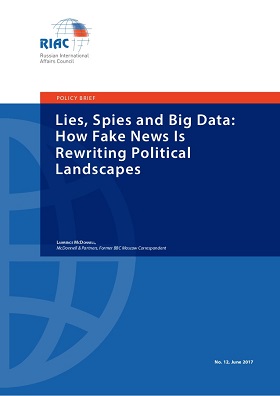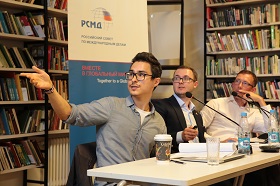Fake news is a purposeful dissemination of false information to manipulate or promote one’s agenda. Mistakes made by journalists who work under the pressure of the time are not fake news in case the journalists can admit their mistakes and take responsibility.
There are many factors that create friendly environment for fake news. First, war or political confrontation is key in this regard.
Secondly, the penchant for conspiracy theories among politicians also fosters fake news.
The third factor is public distrust to expertise, anti-intellectualism and populism.
The fourth factor is the entertaining nature of the news coverage: the easier and more hilarious news is, the bigger audience buys it.
Fifth, leak journalism also has its side effect regardless of the fact that it could be the bedrock of investigative journalism.
The sixth factor is the abundance of information in the Internet. The human brain is unable to process it, which makes it more vulnerable for manipulation.
The seventh factor is the development of new technologies and, particularly, artificial intelligence.
Today it is impossible to resolve the problem of fake news. Realistically, one can only alleviate it. How to do it? First, one should admit that nobody knows the real truth.
Special counsel Robert Mueller, who is running the probe into Russia’s alleged meddling in the U.S. domestic affairs, got the access to Russian-linked ads campaign on Facebook during the presidential election. After he obtained a search warrant for the information, CNN reported quoting an anonymous source on September, 16. Mueller also got the detailed information about the fake accounts that bought the ads and the ways they tried to manipulate Americans. At the beginning of September, Facebook informed Congress that 3,000 ads were ran between June 2015 and May 2017 and were linked to fake accounts, created reportedly by a pro-Kremlin troll factory.
According to the U.S., Russia was rigorously spreading its narrative and “fake news” during the presidential race and contributed to the victory of American billionaire Donald Trump, nominated by the Republican Party. These accusations highlighted the scale of the fake-news problem in the post-truth world. But to understand this phenomenon, it is necessary to determine what the term “fake news” really means. Fake news is a purposeful dissemination of false information to manipulate or promote one’s agenda. Mistakes made by journalists who work under the pressure of the time are not fake news in case the journalists can admit their mistakes and take responsibility.
Historical premises for fake news
The fake news phenomenon is not new. Before its emergence, the purposeful use of false information was an important part of the military strategy in ancient history. For instance, Ancient Greeks used it during the Peloponnesian wars. Ancient Chinese military theorist and strategist Sun Tzu encouraged military leaders to use disinformation in his work “The Art of War”. “All warfare is based on deception. Hence, when able to attack, we must seem unable; when using our forces, we must seem inactive; when we are near, we must make the enemy believe we are far away; when far away, we must make him believe we are near,” he wrote.
Numerous conspiracy theories and forgeries also contained what media experts today describe as fake news. The Donation of Constantine, a doctored Roman imperial decree of the Middle Ages, is based on legends that date back to the 5th century. According to it, the 4th century Roman emperor, Constantine the Great, transferred authority over Rome to the Pope. The authors of the documents are unknown, but they might have concocted the forgery to support the Church’s political claims.
The Protocols of the Elders of Zion, which supposedly appeared in Russia in 1890s, are another example of the attempts to mislead purposely. It is a series of lectures by Jewish conspiracy leaders, who sought to establish global dominance and corrupt the moral values. It is accepted as a false document and dubbed as a ridiculous conspiracy theory.
The use of disinformation is also exemplified in the political forgery of the 19th century – “The Will of The Peter The Great”. It was presumably written for Napoleon Bonaparte, who sought to frighten Europe, to give him excuses to invade Russia. The document’s goal was to impose fears about Russia’s geopolitical ambitions.
“The Will of the Peter The Great” presents the alleged plan of the famous Russian emperor to conquer Europe and spread Russian influence throughout the world. It re-merged during the Crimean War of the 19th century, during the Russian-Turkish war of 1877-1878, the World War I, and the World War II.
Another example of a conspiracy theory is the Allen Dulles’ Plan, named after the former CIA director. According to the Plan, the U.S. had been seeking to destroy the Soviet Union during the Cold War by secretly corrupting the cultural heritage and moral values. The origins of this doctrine remain unknown. It is claimed to have been Dulles’s speech before the U.S. Congress in 1945 or a passage from his book published in 1945 or 1953. However, experts and historians do not confirm this. Curiously, The Dulles doctrine echoes the words expressed by a character in The Eternal Call, a novel by Soviet writer Anatoly Ivanov. In June 2015, a Russian court declared a fictional plot to destroy the USSR to be extremist.
Seven factors: favorable environment for fake news
There are many factors that create friendly environment for fake news. First, war or political confrontation is key in this regard. As long as one country finds itself in the state of confrontation with another, as long as it finds itself politically and economically vulnerable, as long as it experiences inferiority complex or identity crisis, it inevitably leads to the emergence of fake news. One should not go too deep to find the examples, with the ongoing U.S.-Russia confrontation, Russia’s post-Soviet inferiority complex and the identity crisis in Trump’s America.
Secondly, the penchant for conspiracy theories among politicians also fosters fake news. As long as a country or its leadership firmly believes that somebody is trying to organize “color revolutions” or meddle in the presidential elections, this might result in the emergence of fake news. American filmmaker Oliver Stone’s movies and documentaries are believed to promote conspiracy theories. The “House of Cards” by Netflix also portrays the American politics as a series of behind-the-scenes intrigues against different stakeholders. Although experts take such narrative with a pinch of salt, Russian president Vladimir Putin believes that the House of Cards reflects the realities of the U.S. politics and even recommends watching it to his close aides.
The third factor is public distrust to expertise, anti-intellectualism and populism. Recently, ivory tower experts and mainstream media have been out of reach, they do not talk to ordinary people, who feel abandoned. This accounts for the popular skepticism toward experts and the Trump rise. Ironically, the very word “expert” is now being used in a derogatory meaning. “What was already a strong strain of anti-intellectualism has become completely dominant,” wrote Paul Krugman in his July, 12 blog for The New York Times.
The fourth factor is the entertaining nature of the news coverage: the easier and more hilarious news is, the bigger audience buys it. This drives many media, with their struggle to win people’s hearts and minds. However, such approach fails to foster critical thinking. The other side of the coin is fake news or conspiracy theories.
Fifth, leak journalism also has its side effect regardless of the fact that it could be the bedrock of investigative journalism. The media obsession with exclusive information and leaks at times undermines the integrity of journalism.
The sixth factor is the abundance of information in the Internet. The human brain is unable to process it, which makes it more vulnerable for manipulation. This creates the situation, when people are reluctant to think. In fact, they prefer to rely on others’ opinions without assessing the information critically. Nasim Taleb described it as an information noise in his book “The Black Swan.”
The seventh factor is the development of new technologies and, particularly, artificial intelligence. In July, 2017 a team of computer scientists from University of Washington presented the artificial intelligence video software that turned different audio clips into a realistic, lip-synced fake video of the U.S. former president Barack Obama. In the situation of political confrontation and unpredictability, it could lead to a large-scale regional or even global conflict.
How to tackle fake news
Today it is impossible to resolve the problem of fake news. Realistically, one can only alleviate it. How to do it? First, one should admit that nobody knows the real truth. Psychologically, overconfidence and complacency create the environment, in which people disregard the possibility that they might be manipulated. The more over-confident people are, the more vulnerable they are to fake news. In this situation, experts, journalists and audience should be more critical to themselves. "I know that I know nothing," a well-known philosopher, Socrates once said. His words should serve as a rule to withstand fake news. It creates a sort of immunity against mistakes and manipulation. It is the premise.
Second, it is necessary to develop the culture of honest discussion, polemics and the culture of disagreement. The advice of French 18th century writer Voltaire is relevant in this regard. “I disapprove of what you say, but I will defend to the death your right to say it,” he supposedly said.
Third, it is important to make the news coverage less entertaining or at least draw a clear line between entertainment and journalism. Believe it or not, but today people might take political satire seriously. For example, a Russian journalist took seriously a joke of Andy Borowitz, an American political satirist from New Yorker, in May 2015. “Senator John McCain on Thursday proposed military action to ‘dismantle and destroy FIFA once and for all.’ <…> ‘We must make FIFA taste the vengeful might and fury of the United States military’,” Borowitz reported in May, 2015. American politicians “have entirely lost the sense of reality” if they want to start military operation against FIFA, a journalist from a Russian official newspaper, responded to The New Yorker.
Paraphrasing The Guardian’s former editor-in-chief C.P. Scott who once told “Comment is free, but facts are sacred”, entertainment is free, but news are sacred. Ironically, today audience fails to even separate opinions from news sometimes, which yet highlights the scale of the problem.
Finally and most importantly, diligent fact-checking and fostering media literacy in universities and schools could be helpful to alleviate the problem of fake news. Creating different media resources and journalism exchange programs to withstand fakes news is one of the ways to deal with the challenge. For example, “Make Facts Great Again”, a joint journalist project initiated by the participants the European Solidarity Center’s program, could be a good example.
Fake news mantra
Today the fake news mantra is frequently used in politics as an argument to discredit critics or unfavorable coverage. Trump describes the mainstream American media as “failing”, the “Enemy of the American people”. Likewise, the Russian Foreign Ministry uses the fake news stigma to refute inconvenient narratives. For instance, in the early April, 2017 it labeled Kommersant’s interview with NATO’s Deputy Secretary General Rose Gottemoeller as fake news only because it used Gottemoeller’s quote in the headline. NATO did not have plans to strengthen its eastern borders before the Ukrainian conflict, the headline reads.
These examples indicate that the fake news phenomenon is a challenge for both Russia and the West, and they had better tackle it together through dialogue and cooperation.








